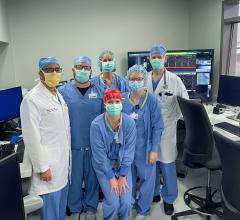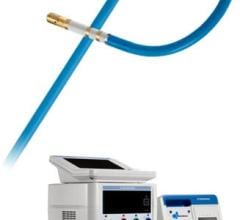
January 3, 2017 — St. Jude Medical Inc. announced U.S. Food and Drug Administration (FDA) clearance of its EnSite Precision cardiac mapping system and Advisor FL Circular Mapping Catheter, Sensor Enabled in December.
The new EnSite Precision cardiac mapping system is the latest addition to the company’s electrophysiology portfolio, and is designed to provide automation, flexibility and precision in cardiac mapping during the treatment of patients with abnormal heart rhythms (cardiac arrhythmias). This next-generation platform has been used in thousands of cases in electrophysiology labs and hospitals across Europe since receiving CE Mark in January 2016.
When physicians use catheter ablation to treat abnormal heart rhythm, a small area of heart tissue under the tip of the ablation catheter is heated by high-frequency energy, creating a lesion or tiny scar. As a result, this tissue is no longer capable of conducting or sustaining the arrhythmia. Cardiac mapping provides a live view of the heart so physicians can visualize and navigate cardiac anatomy to deliver more precise ablation therapy. The new EnSite Precision cardiac mapping system offers a new dual-technology platform that provides highly detailed anatomical models and maps to enable more efficient treatment of a wide range of arrhythmias — including complex arrhythmias, such as atrial fibrillation or ventricular tachycardia.
“The new EnSite Precision cardiac mapping system allows more mapping data to be collected in a shorter amount of time compared to today’s technologies,” said John Day, M.D., medical director of the Intermountain Heart Rhythm Specialists at the Intermountain Medical Center Heart Institute in Salt Lake City, who is set to perform the first case in the United States. “We look forward to implementing the EnSite Precision cardiac mapping system and the new St. Jude Medical Sensor Enabled tools to help guide therapy and provide expanded procedural options to tailor care for patients in simple to complex ablation scenarios, as well as deliver a new level of accuracy and speed in our procedures.”
The EnSite Precision system introduces new solutions, including the EnSite AutoMap Module, which will enable the electrophysiologist to more quickly perform morphology matching that identifies the source of the irregular heartbeat using automated cardiac rhythm mapping tools to facilitate treatment. The AutoMap Module includes the new TurboMap feature, which will allow the physician to build a map of the heart 10 times faster than current systems using recorded data.
For more information: www.sjm.com


 March 27, 2025
March 27, 2025 








